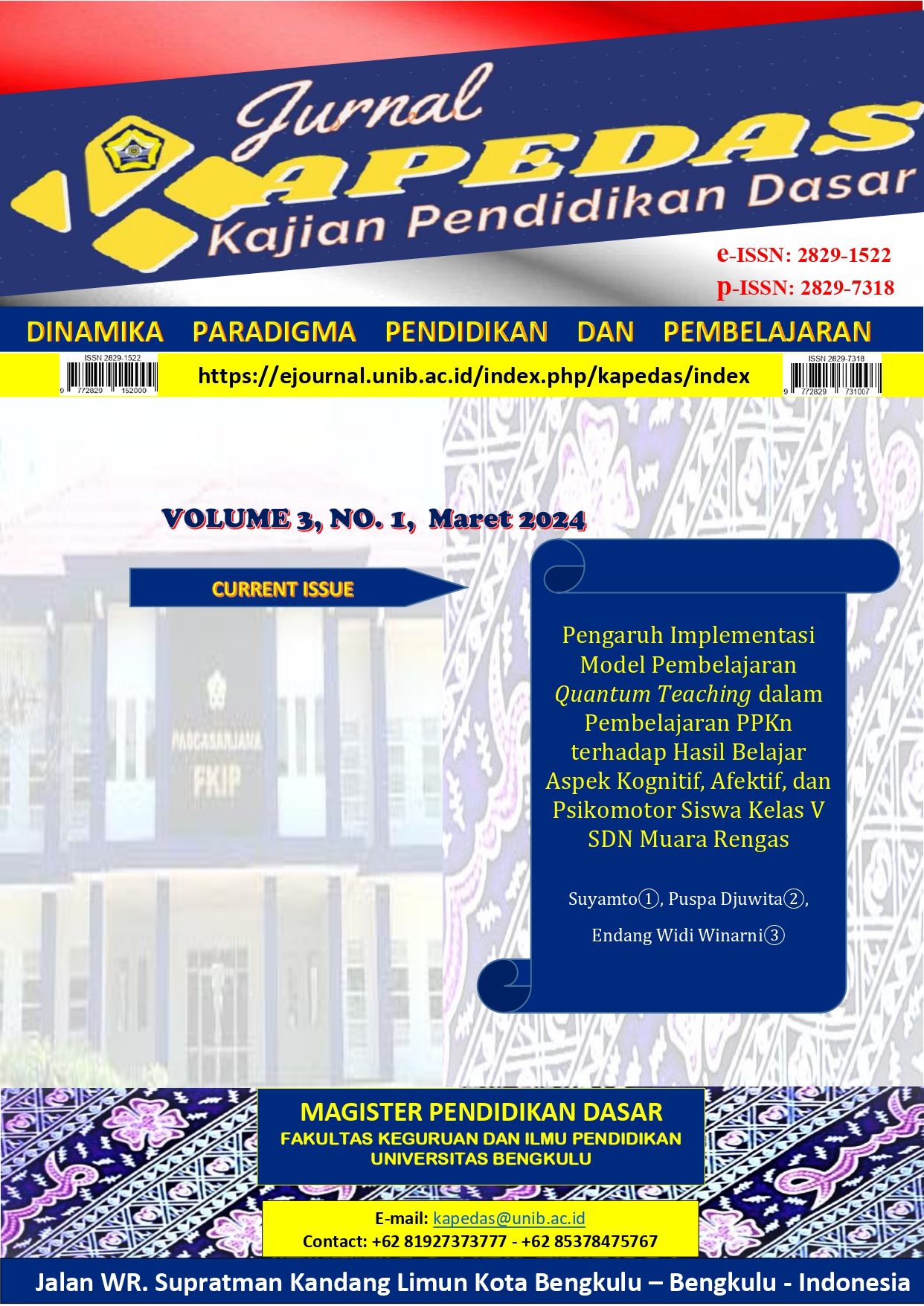Main Article Content
Abstract
This research aims to develop a PBL (Problem-Based Learning) oriented flipbook in improving factual and conceptual knowledge. The problem of this research is the low learning outcomes of students on factual and conceptual knowledge. The purpose of this study was to design and test the effectiveness of PBL-oriented flipbooks in improving students' factual and conceptual knowledge. This research uses a 4D development approach (Define, Design, Develop, Disseminate). The Define stage involves identifying the needs, objectives, and context of the study. The Design stage involves designing the initial design of the product or model to be developed. The Develop stage involves the implementation and development of the product or model. The Disseminate stage involves disseminating and evaluating the product or model to relevant stakeholders. The results of flipbook development research show that PBL-oriented flipbook digital teaching materials are feasible to use. Student response was positive, with 91% of students meeting the criteria for either. This teaching material has also proven effective in improving factual and conceptual knowledge, as shown by the average N-gain score in the experimental class of 0.63 (medium category), while in the control class it was only 0.20 (low category). The conclusion of flipbook development research shows that PBL-oriented flipbook digital teaching materials are worth using. Student response is positive, and effective for improving factual and conceptual knowledge.
Article Details
Copyright (c) 2024 Elva Susanti, Irwan Koto, Endang Widi Winarni

This work is licensed under a Creative Commons Attribution-ShareAlike 4.0 International License.

Karya ini dilisensikan di bawah Creative Commons Attribution-ShareAlike 4.0 International License .
References
-
Erander, S., Winarni, E., W., & Koto, I. (2023). Pengembangan Video Pembelajaran Berbasis Model Problem Based Learning (PBL) Materi Siklus Air Kelas V SD untuk Meningkatkan Berpikir Kritis. Jurnal Kapedas: Kajian Pendidikan Dasar, 2(1). 91-100
Krathwohl, D. R. (2002). A Revision of Bloom's Taxonomy: An Overview. Theory into Practice, 41(4), 212-218. Taylor & Francis, Ltd. Retrieved from http://www.jstor.org/stable/1477405
Rahmadhani, Y., Koto, I., & Winarni, E. W. (2021). Analisis Kualitas Butir Soal Ujian Sekolah Mata Pelajaran IPA Berdasarkan Dimensi Pengetahuan Faktual dan Konseptual Ditinjau Dari Konten dan Konteks. Jurnal Pembelajaran dan Pengajaran Pendidikan Dasar. 4(1), 1-12
Savery, J. R. (2006). Overview of Problem-based Learning: Definitions and Distinctions. Interdisciplinary Journal of Problem-Based Learning, 1(1), Article 3.
Simangunsong I.T., Damanik D.P., & Panjaitan J. (2020). Peningkatan Pengetahuan Konseptual Siswa dengan Menggunakan Model Problem Based Learning. Jurnal Darma Agung. 28(1), 100-105.
Sözen, M., & Bolat, M. (2011). Determining the misconceptions of primary school students related to sound transmission through drawing. Jurnal Procedia Social and Behavioral Sciences, 15, 1060-1066.
Suherja A., Winarni E.W., & Koto, I. (2022). Pengembangan Bahan Ajar Digital Berbasis Pendekatan Kontekstual Dengan Materi Hubungan antar Komponen Ekosistem dan Jaring-Jaring Makanan di Lingkungan Sekitar. Jurnal Pembelajaran dan Pengajaran Pendidikan Dasar. 5(2), 295-305.
Winarni, E.W. (2018). Penelitian Kuantitatif Kualitatif. Bumi Aksara. Jakarta
____________ . (2018). Pendekatan Ilmiah Dalam Pembelajaran Kreatif Dan Inovatif. Bengkulu: FKIP UNIB.
Wisudawati & Sulistyowati. (2014). Metodologi Pembelajaran IPA. Jakarta: Bumi Aksara
References
Krathwohl, D. R. (2002). A Revision of Bloom's Taxonomy: An Overview. Theory into Practice, 41(4), 212-218. Taylor & Francis, Ltd. Retrieved from http://www.jstor.org/stable/1477405
Rahmadhani, Y., Koto, I., & Winarni, E. W. (2021). Analisis Kualitas Butir Soal Ujian Sekolah Mata Pelajaran IPA Berdasarkan Dimensi Pengetahuan Faktual dan Konseptual Ditinjau Dari Konten dan Konteks. Jurnal Pembelajaran dan Pengajaran Pendidikan Dasar. 4(1), 1-12
Savery, J. R. (2006). Overview of Problem-based Learning: Definitions and Distinctions. Interdisciplinary Journal of Problem-Based Learning, 1(1), Article 3.
Simangunsong I.T., Damanik D.P., & Panjaitan J. (2020). Peningkatan Pengetahuan Konseptual Siswa dengan Menggunakan Model Problem Based Learning. Jurnal Darma Agung. 28(1), 100-105.
Sözen, M., & Bolat, M. (2011). Determining the misconceptions of primary school students related to sound transmission through drawing. Jurnal Procedia Social and Behavioral Sciences, 15, 1060-1066.
Suherja A., Winarni E.W., & Koto, I. (2022). Pengembangan Bahan Ajar Digital Berbasis Pendekatan Kontekstual Dengan Materi Hubungan antar Komponen Ekosistem dan Jaring-Jaring Makanan di Lingkungan Sekitar. Jurnal Pembelajaran dan Pengajaran Pendidikan Dasar. 5(2), 295-305.
Winarni, E.W. (2018). Penelitian Kuantitatif Kualitatif. Bumi Aksara. Jakarta
____________ . (2018). Pendekatan Ilmiah Dalam Pembelajaran Kreatif Dan Inovatif. Bengkulu: FKIP UNIB.
Wisudawati & Sulistyowati. (2014). Metodologi Pembelajaran IPA. Jakarta: Bumi Aksara
